Work horses are big, strong, and friendly animals. They have been helping people for many years by doing heavy work that humans could not do alone. They’re a big part of our history and how we got to where we are today.
A draft horse is a large horse that people have bred to do heavy jobs like plowing fields, working on farms, pulling logs in the forest, and moving large loads. Some, but not all, of these horses have feathers on their legs, which makes them look even more unique.
There are many different breeds of these work horses, known as drafts; like the Shire, Clydesdale, Percheron, Belgian Draft, and Haflinger.
Most of them are pretty tall, between 16-19 hands but there are some smaller work horse breeds between 14 and 16 hands. A hand is a way that people measure horses. One hand is about four inches, so you can imagine how tall these horses are! Most of them also weigh over 1,500 pounds.
The name ‘draft horse’ comes from the English word “dragan” which means “to draw or haul”. It fits these horses perfectly because that’s what they were bred to do: draw and haul heavy stuff. They’re very strong, but they’re also very calm and patient, which is why farmers prefer working with them.
In the past, when there were no machines to do heavy work, these horses were super important to everyday life. They were the tractors and trucks of their time. Today, even though we have machines to do most of the heavy work, some people still use draft horses for farming, logging, showing in horse events, having fun, and other tasks. These horses are also sometimes used bred with lighter horse breeds, like the Thoroughbred, to create sport horses.
One fun event that still celebrates these amazing animals is the Old Farmers Day festival in Louisiana. At this festival, workhorse competitions happen, where different horse breeds show off their strength by pulling logs and plows. A workhorse can be any horse that does work with people, like carrying things around or pulling carts and plows.
If you’re thinking about getting a draft horse for your farm, it’s important to not only learn about all the different breeds to consider but get solid experience with horses and a strong foundation in equine knowledge. Each breed has its own special qualities. They’re all strong, patient, and easy to get along with, but some might be better for certain jobs or situations.
The History of Work Horses
Work horses, especially draft horses, have a significant place in human history. Let’s look at their journey from ancient times to the present day.
The Middle Ages
Initially, horses in the Middle Ages weren’t as big as today’s draft horses. They were strong and sturdy, sure, but smaller. People used them for farming, transportation and even in battles.
The 19th Century
The 19th century marked a turning point for work horses. During this time, people wanted bigger, stronger horses and started to breed them for this purpose. They used them for heavy-duty tasks like hauling heavy loads, pulling carriages, and working on farms. This period saw the rise of the draft horses that we recognize today.
World Wars
Work horses, particularly draft horses, served in World Wars I and II. They were invaluable for their strength and ability to transport heavy equipment on battlefields.
20th Century Developments
Despite new machinery and cars in the early 20th century, work horses still had a role to play. But by the 1950s and ’60s, many work horse breeds were at risk of disappearing due to technological advancements, basically people choosing machinery over horses.
Today’s Work Horses
Today, work horses, specifically draft horses, are still relevant. They participate in horse events and even pleasure riding.
You’ll also still find them in logging operations and on small farms. In fact, groups like the Amish and Mennonite communities depend on them as a renewable source of power.
Draft Horses Around the World
In the late 19th and early 20th centuries, America imported many draft horses from Western Europe. This included the:
- Percheron from France
- Belgian from Belgium
- Shire from England
- Clydesdale from Scotland
Despite their reduced numbers in the 20th century, dedicated breed enthusiasts work hard to ensure these breeds don’t disappear.
In places like Mackinac Island in the United States, you’ll still find draft horses used for transportation. Personally I have even see Amish driving horse and buggies near my parents home in Maine.
These majestic work horses continue to serve in modern society, demonstrating their enduring relevance and resilience.
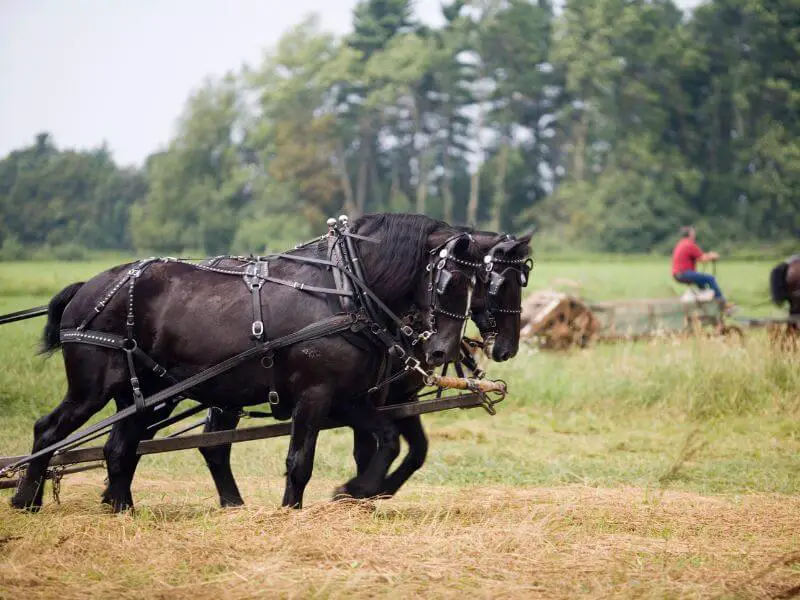
#1 Percheron Horses: A Breed Built for Hard Work
Have you ever seen a Percheron horse? The last barn I was leasing a horse at called Low Places Ranch, had two large black Percherons. These animals are big, strong, and incredibly hard-working. The farm used them for carriage rides around the property and recreation, but most of their days they enjoyed hanging out in a very large pasture.
Percherons come from a region in France called Le Perche, and they’re one of the most famous draft horse breeds in the world.
A Workhorse Through and Through
What makes a Percheron stand out is their amazing strength. These horses usually weigh between 1,600 and 2,600 pounds and stand tall between 15 and 19 hands (that’s 5 to 6 feet in height).
This makes them great for any job that needs muscle, like pulling heavy loads or working in fields.
A Powerful Yet Graceful Breed
Percheron horses are not just strong, they’re also very elegant. They have beautiful heads probably due to Arabian breed influence and their bodies are strong and well-muscled.
Their movement is powerful, yet they move with grace.
They come in beautiful colors too, but the most common colors are gray and black.
Percheron Horses at Work
Percherons are truly the workhorses of the horse world.
They’re smart, they’re willing to work, and they have the strength to handle big jobs.
These horses were used in wars and to do farm work long before tractors and trucks came along. Today, they still do heavy work like forestry, pulling heavy loads, and some even do police work.
Percheron Popularity
Percherons have always been popular, both in France and in the United States.
In fact, at one point before the Second World War, about 70% of all the draft horses in the US were Percherons.
Their numbers went down after the war because of the switch to machines, but they’re still a common sight in both countries, proving that they’re a trusted and reliable breed.
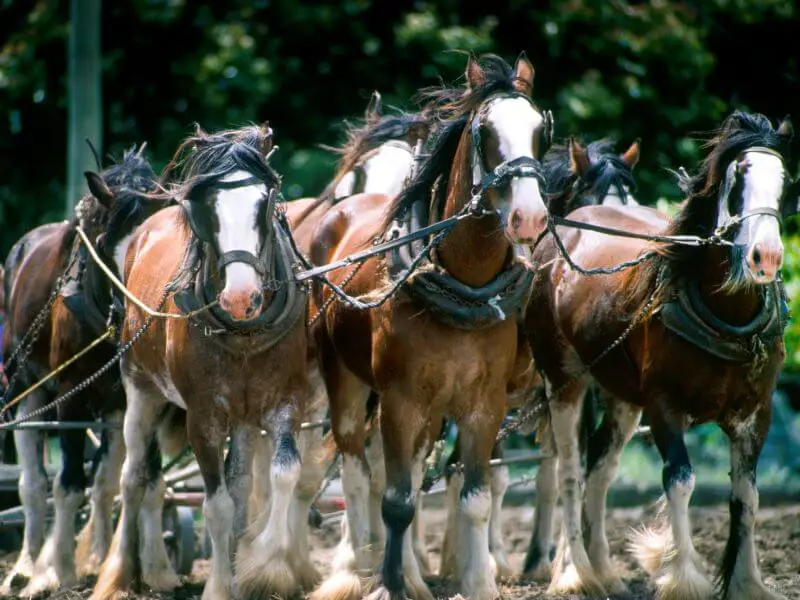
#2 Clydesdale: The Premier Work Horse
The Clydesdale horse has a long and rich history as a work horse. This breed of draft horse, originally from Scotland, has been an essential part of farming and transportation for centuries.
Clydesdale’s Historical Roots
Clydesdale horses were developed in the late 18th and early 19th centuries in Clydesdale, now known as Lanarkshire, in Scotland.
These horses were bred to be sturdy and strong. They were the result of breeding Flemish stallions with local mares, and later, Shire horses were also introduced into their lineage to further improve the breed. Which is probably why they can sometimes look so similar to Shires.
Physical Features
Clydesdales are very large, standing between 16 and 18 hands tall. Some Clydesdales can even grow up to 21 hands high! Actually Low Places Ranch, also had a Clydesdale who was at least 21 hands maybe taller.
They typically weigh between 1,700 and 2,200 pounds, although some can weigh as much as 2,700 pounds. This size and strength made them ideal for heavy work tasks.
These horses are muscular, with well-arched necks. They have unique feathering around their hooves, and their coats are most commonly bay in color. Clydesdales also have beautiful and intelligent eyes.
Role as a Work Horse
In the early days, Clydesdales were essential for farm work and road transportation.
Their size and strength made them perfect for these heavy tasks. They were bred to be stockier and heavier to handle the workload. Clydesdales were built well to plow fields, pull carts full of goods, and transport people.
Breed Evolution
Over the years, the number of the Clydesdales has changed dramatically. With the introduction of machines for farming and transportation, the need for draft horses like the Clydesdale decreased. By the 1970s, the Clydesdale breed was even in danger of extinction.
Today, Clydesdales are used less for farming and more for carriage driving, riding, and promotional work. Breeders have shifted towards developing a taller, narrower, and more athletic Clydesdale horse.
Clydesdale Today
Even though Clydesdales are not used as much for heavy work as they used to be, they are still a symbol of strength and endurance.
They represent a time when horsepower was the primary source of energy for work and transportation.
Clydesdales remind us of our history, showing how far we have come and how much we owe to these magnificent animals.
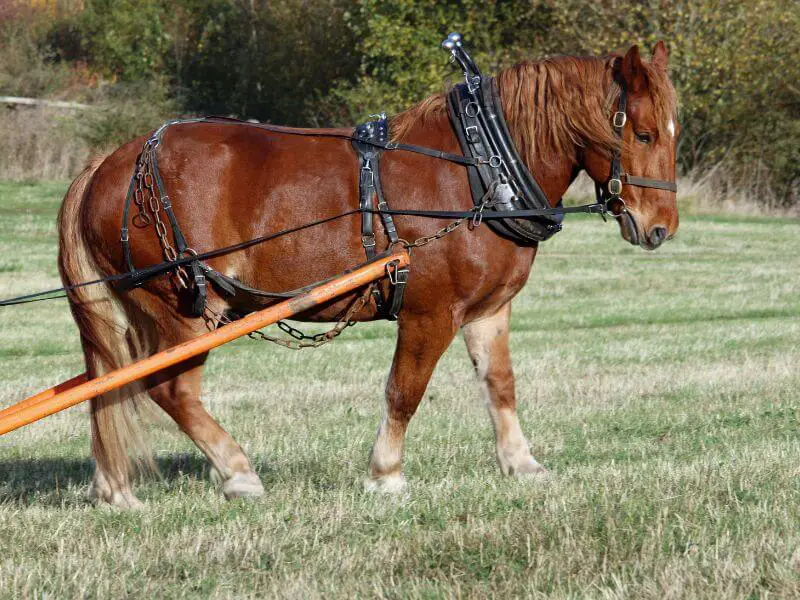
#3 Suffolk Punch: A Uniquely Hardworking Breed
The Suffolk Punch, originating from England’s Norfolk and Suffolk counties, is a true standout among work horses. Here’s why:
Bred for Work
From the beginning, the Suffolk Punch was designed for hard labor.
Unlike other heavy horse breeds, it wasn’t meant for pulling carriages. Instead, it spent its days on farms, doing heavy lifting and even pulling artillery during wars.
Distinctive Physical Traits
- Size: These horses aren’t the tallest, standing only 15-18 hands high, but they pack a lot of strength in their size.
- Weight: Weighing between 1,600 and 2,425 pounds, they’re strong enough to handle heavy tasks with ease.
- Appearance: Always a chestnut color, they have large muscular builds and thick necks, built for endurance and strength.
Work Ethic and Temperament
Suffolk Punch horses are known for their incredible work ethic. They’re eager to work, making them a great choice for tasks that require a lot of effort.
Additionally, they have a good temperament, making them easier to work with than some other horse breeds.
Economical Choice
Another great feature of Suffolk Punch horses is that they eat less than other horse breeds and are easy keepers, which makes them a more economical choice for work horses.
Population Status
While Suffolk Punch horses were once common like other draft breeds, their population has dropped, and they’re now considered a rare breed. Efforts are underway to increase their numbers and keep this amazing work horse breed from disappearing.
The Suffolk Punch is a versatile, robust, and economical choice when it comes to work horses.
It’s easy to see why this breed, with its long history and hard-working nature, has won the hearts of many. If you’re interested in work horses, the Suffolk Punch is certainly a breed to consider.
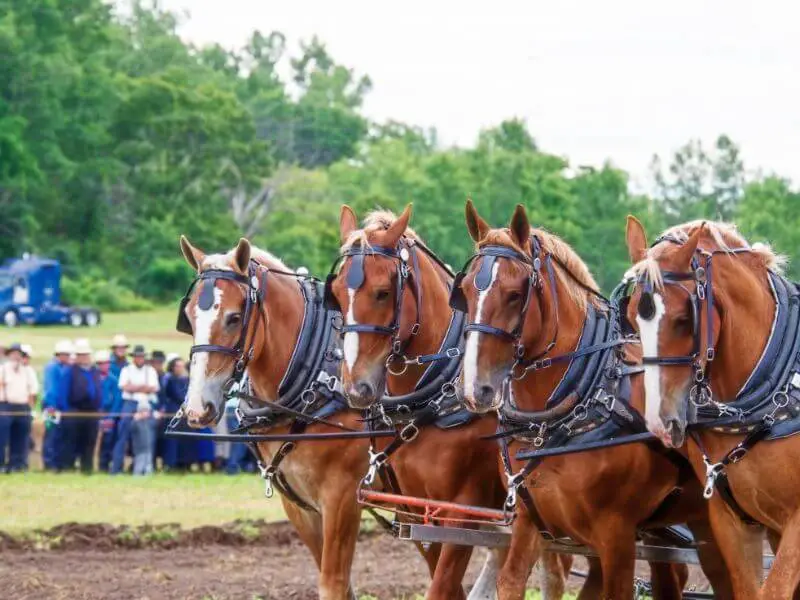
#4 Belgian Draft Horse: A Reliable Workhorse
The Belgian Draft horse is another powerful breed that’s well-known for its ability to handle a wide range of tasks. Originally from the Brabant region in Belgium, this breed has a long history of being used for heavy-duty work.
History and Origin
Belgian Draft horses were bred from the Great Flemish Horse in the 1800s. These strong horses were first used in wars.
It was only in the 1940s that the Belgian Draft became its own breed, separate from the Brabant horse.
This is why you might sometimes hear the Belgian Draft horse called a “Brabant” or you may also hear thar Brabant is a separate breed.
Physical Features
The Belgian Draft horse is really big. It usually stands about 16.5-19.5 hands high and weighs between 1,800-2,200 pounds. Remember the world’s tallest horse is a Belgian Draft named Big Jake, who is an amazing 22 hands plus in height.
Belgian Draft horses are not just tall and heavy. They are also strong and muscular. They have sturdy heads, thick stylish necks, and their bodies have light feathering.
Coat Color
The color of their coat is often sorrel or roan.
In the United States, the Belgian Draft horses are usually a light chestnut color. These horses are also taller and lighter in body than the ones from Belgium.
Temperament
Belgian Draft horses might seem a little stubborn when you first meet them, but they become friendly and calm once they get to know you. These horses are also very smart. I have experienced first hand working with my cousins Belgian drafts, they are very smart and strong, but also have kind temperaments.
Uses of Belgian Draft Horses
Nowadays, Belgian Draft horses are often used for work on farms, for pulling heavy loads like logs, and for riding. They’re also great for showing in horse shows. My cousin rides her Belgian in Pony Club and trail riding.
These horses are so good at what they do that they’re the most popular workhorse in America.
If you need a reliable workhorse, the Belgian Draft is a great choice.
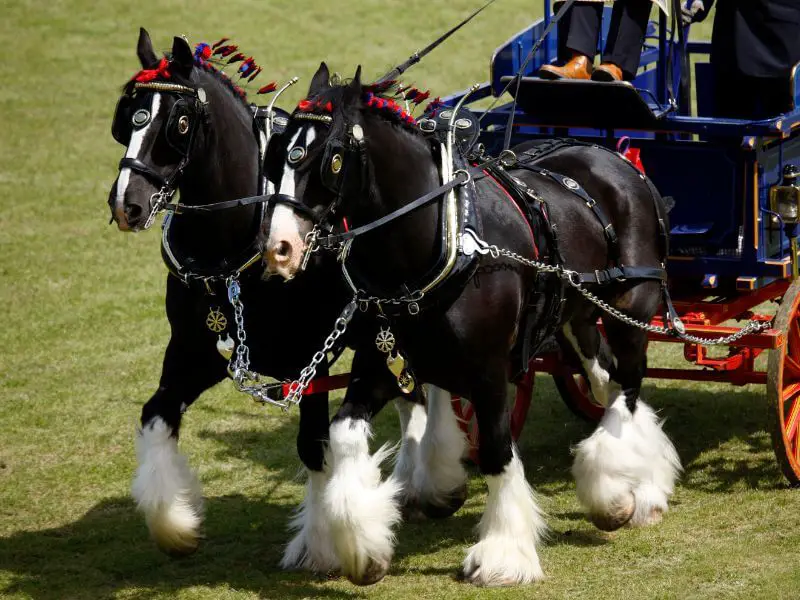
#5 The Shire Horse: The Ultimate Workhorse
If you think about a workhorse, one breed should come to mind: the Shire horse. This mighty breed stands out with its size, strength, and the role it has played throughout history.
Size and Strength Of A Shire
Let’s start with their size. Shire horses are big. How big, you ask? They typically stand between 16-19 hands tall, or about 5.3 – 6.3 feet. This makes them one of the tallest horse breeds around.
And they’re not just tall – they’re also strong. A Shire horse can weigh between 1,800-2,500 pounds. Their bodies are muscular, and they have broad chests and deep shoulders, which means they’re very good at pulling heavy loads.
Shire’s Historical Roles
Shire horses have been working horses for a very long time. They’re believed to be descendants of the Great English Horse, which was used in battles many years ago. In the mid-1800s, people in the United Kingdom started breeding Shire horses, and they quickly became popular for a number of jobs.
One of the jobs Shire horses were used for was farming. They’re strong enough to pull heavy plows, making them very useful in the fields.
Another job they had was hauling. Because of their size and strength, Shire horses could pull heavy loads for long distances.
In the past, some breweries in the UK even used Shire horses to deliver beer. The horses would pull carts filled with beer barrels from the brewery to pubs and other places. This practice is rare today, but a few traditional breweries still do it.
Modern Day Uses
Even though we have machines for farming and hauling now, Shire horses are still used as work horses today. They’re used for plowing fields, and their calm nature makes them good for riding too.
Unfortunately, Shires have also decreased over the years. But efforts are being made to keep the breed alive. The Shire horse is a symbol of strength and hard work, and it continues to be a valued part of English culture.
#6 Boulonnais: A Remarkable Work Horse
The Boulonnais horse is a breed known for its strength and endurance. This breed comes from Boulogne, France, and has a history that dates back to the time of Julius Caesar. They’re often referred to as “white marble” horses due to their common white and gray coats.
Physical Traits of the Boulonnais
Boulonnais horses are quite large like most draft horses but not the biggest breed. They can be anywhere between 14.3 and 16.3 hands tall, with adults weighing from 1,400 to 1,650 pounds.
Their size and strength make them perfect for heavy work. But, they’re not just strong, they are also attractive looking horses.
They have a short head, wide forehead, muscular neck, broad chest, and straight back. Their legs are strong and they have a thick mane, which adds to their majestic appearance.
A Work Horse Like No Other
The Boulonnais is more than just a big, strong, good looking horse.
It is also known for its calm, friendly nature. This breed is gentle and easy to train, making it ideal for work, whether in the fields or for general riding. They’re energetic, too, always ready to do their job and do it well.
Influence on Other Breeds
What’s also fascinating about the Boulonnais is its impact on other breeds. Its traits have been passed down to other horse breeds, including the Percheron. This showcases the value and influence of the Boulonnais in the world of work horses.
Surmising The Boulonnais Horse
The Boulonnais horse is a great work horse. It’s strong, friendly, easy to train, and good at its job. Plus, it’s a horse with a rich history and impact. If you’re looking for a hardworking horse breed, the Boulonnais is definitely worth considering.
#7 Ardennes: A Legendary Workhorse
The Ardennes horse breed comes from Europe, more specifically, a region called the Ardennes, spanning France, Belgium, and Luxembourg.
Believe it or not, these horses date back to Ancient Rome, making them, not the oldest but one of the oldest horse breeds in the world.
What’s more, they have even contributed to creating other breeds like the Russian Heavy Draft, Comtois, and Sokolsky horses.
Ardennes Physical Traits
When you first see an Ardennes horse, you’ll notice their strong, bulky and muscular body right away.
These animals stand, around 15 to 16 hands high, not the tallest but they can weigh nearly 2,200 pounds! Lending them a spot on the list for biggest horses in the world. Besides their bulk, you might also notice their colors.
They usually have bay or roan coats, but you could sometimes see chestnut, palomino, and grey shades too.
A Born Workhorse
Now, here’s where the Ardennes truly shine – they were born to work.
These horses were mainly used for draft work, meaning they were great at pulling and moving heavy things.
If you need a strong horse to pull a plow or a carriage, an Ardennes is what you want. Their muscular legs make them super powerful, capable of pulling heavy loads for a long time.
Modern Uses
Even today, Ardennes horses are often seen doing hard work.
They are used on farms to pull equipment and are also becoming more popular in competitive driving. However, being a workhorse doesn’t mean they only work all the time.
In fact, their calm nature and good manners make them perfect for a relaxing ride too.
In a Nutshell
The Ardennes horses are a real workhorse breed. They are strong, resilient, and hardy, making them perfect for heavy work.
But they’re not all about strength – they are also kind and patient, great traits for any horse and a common one for draft horses, you probably realize by now.
Whether you’re a farmer needing a reliable draft horse or a heavier beginner looking for an strong horse to ride, you won’t go wrong with an Ardennes.
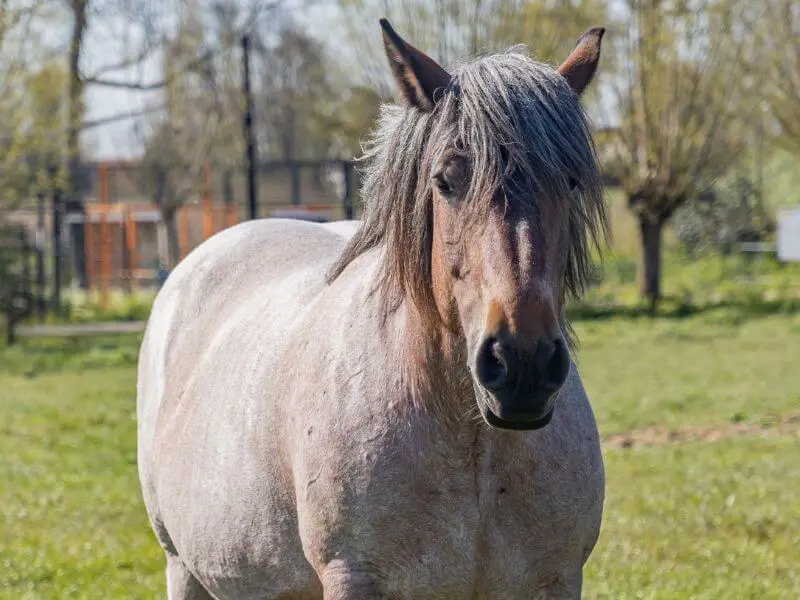
#8 Dutch Draft Horse: A Stellar Workhorse
The Dutch Draft horse comes from the Netherlands. They were first made in 1918, after the end of World War I.
To make them, people mixed two types of horses – the Brabant and the Ardennes. The goal was to get the best parts of both breeds.
Dutch Draft Horse’s Size
Dutch Draft horses are not the tallest but are still very big. They stand between 15.2 to 16 hands high and weigh around 1300 to 1700 pounds. This is very heavy for the height to weight ratio, which means these horses are buff.
Appearance of the Dutch Draft
These horses can be many colors. They can be chestnut, gray, black, or bay. They have a lot of hair on their lower legs, which is known as ‘feathering’. They also tend to have a thick mane.
The Breed’s Nature
Even though they look big and strong, Dutch Draft horses are very calm. They are also very smart and have a lot of energy.
The Dutch Draft Horse at Work
Dutch Drafts were another horse bred for work. They are very strong and can move very heavy things. Even after farming started to use machines, these horses still had jobs to do.
People use Dutch Draft horses for many things today. They are great for riding just for fun. They are also used in a sport called dressage. Dressage is a special type of horse training and competition. But Dutch Draft horses are also still used on farms. They can do a lot of work that machines can’t do.
The Dutch Draft horse is a great example of a workhorse. It’s strong, smart, and can do many types of jobs. Despite changes in farming, this horse breed continues to be important. Whether on a farm or in a competition, the Dutch Draft horse is always ready to work.
#9 Jutland Horse: The Ultimate Workhorse
The Jutland horse is a popular draft breed that has its roots in Denmark, particularly in the Jutland Peninsula. This horse breed is named after this region, showing its deep historical ties to the area.
History and Origin of the Jutland Horse
The Jutland horse was used by the Vikings in the 9th century. These powerful horses were perfect for the hard tasks that the Vikings needed to perform.
The modern Jutland horse has been around since the late 19th century. It is believed that the Jutland horse might have some connections to other horse breeds such as the Suffolk and Shire horses.
Appearance and Physical Characteristics
- Height: Jutland horses stand at about 15-16.1 hands tall.
- Weight: They usually weigh between 1,500-1,800 pounds.
- Color: Most Jutland horses are chestnut. However, they can also be gray, black, and roan. Some may even have white markings.
- Body: They have strong shoulders and hindquarters. These are important features that make them great for hard work. They also have feathering on all legs.
Temperament
Jutland horses are gentle and calm. Even though they are big and strong, they are easy to work with. This makes them ideal for kids and people who are new to horse handling.
Role as a Workhorse
The Jutland horse is known for its ability to do heavy work. It’s strong and hardy, which makes it great for farm work. In fact, it was originally used on farms in Denmark. These horses are great at pulling heavy loads, thanks to their powerful muscles. They have a calm and willing nature, which makes them easy to work with.
Even today, the Jutland horse is used as a workhorse. For example, the Carlsberg Brewery in Copenhagen uses Jutland horses to move beer around the city.
Despite the changes in how we use horses today, the Jutland horse remains a top choice when it comes to doing heavy work. They are not just strong; they are also gentle, reliable, and hardworking.
Note: It’s important to know that there are not many purebred Jutland horses left. Only about 1000 of them are thought to be left in the world.
#10 American Cream Draft: A True Workhorse
The American Cream Draft horse, with its notable cream color, is a unique horse breed from the United States. It’s a decent sized horse, standing at a height of 15.0hh to 16.3hh and weighing between 1600 to 2,000 pounds.
Role on the Farm
These horses were bred to be workhorses. In the past, they were an essential part of many farms.
They are very strong. With their thick muscles, they were able to pull heavy things like carriages and farm tools. They were very useful before we had machines to do farm work.
Why Are They Good Workers?
The American Cream Draft is not just strong, it’s also another draft that is friendly and easy to work with. They are known for being gentle and willing to learn. This makes them a great choice for people who are new to working with horses.
Can They Do Other Things?
While their history is deeply rooted in farm work, these horses are also good for riding and showing. This is because they are especially easy to handle. But their main role has always been as a workhorse.
The Future of the American Cream Draft
Today, even though machines do a lot of the work on farms, the American Cream Draft horse still has a place as a workhorse. They continue to show us their strength and their friendly nature, making them a beloved breed in the United States.
So, if you are looking for a workhorse, consider the American Cream Draft. It’s strong, friendly, and a true American breed.
Remember, a workhorse is more than just a strong horse. It’s a horse that is willing to work with you. The American Cream Draft is just that kind of horse.
With their unique cream color and amber eyes, they are not just a workhorse but also a beautiful one.
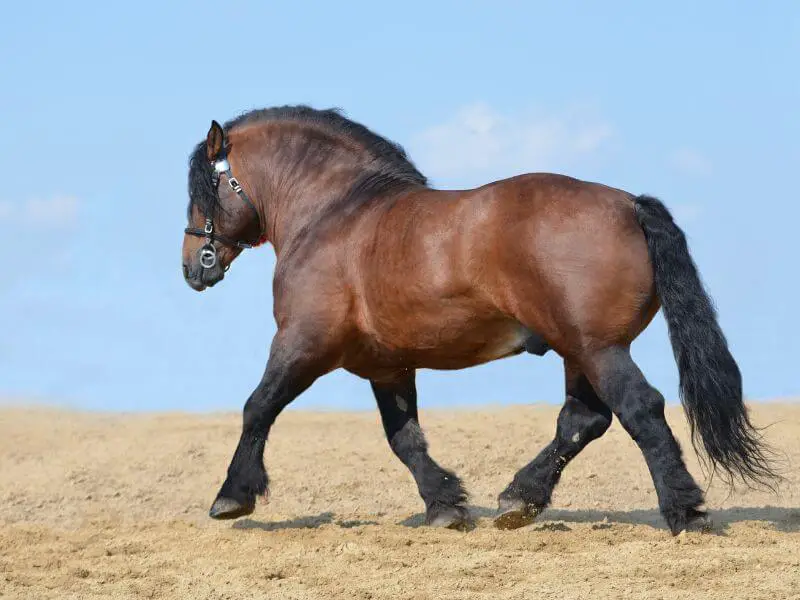
#11 Russian Heavy Draft: The Ideal Work Horse
The Russian Heavy Draft horse is one of the strongest horse breeds out there. This horse breed started in Russia during the 1800s.
The main reason for creating this breed? Farm work and hauling. This is where they shine.
The Breed’s Background
They come from a mix of other horse breeds, such as the Brabancon, Percheron, and Orlov Trotter. Combining these breeds gave the Russian Heavy Draft horse its strength and size.
Even though they’re smaller compared to other draft horses, they stand about 14.1-15 hands tall and weigh around 1,400-1,500 pounds. Their smaller size doesn’t stop them.
They’re still strong and energetic, perfect for hard work on a farm.
A Horse with a Great Temperament
What’s really special about the Russian Heavy Draft horse is its character.
They’re patient, friendly, and easy to handle. They don’t mind the cold weather either, which makes them excellent for working in different climates.
Russian Heavy Draft Today
Nowadays, Russian Heavy Draft horses are still used for farm work. But, they’re also great for milk production. That’s right!
The mares of this breed can produce a lot of milk during their lactation period. This makes them a super helpful addition to farms across Central Asia.
In a nutshell, if you’re looking for a reliable, strong, and easy-to-handle work horse, the Russian Heavy Draft horse is a top choice.
Their strength, friendly nature, and ability to produce milk make them a great asset to any farm.
#12 Vladimir Draft Horses: THE VERSATILE WORKHORSE
Do you know which horse breed is famous for its hard work and friendly nature? It’s the Vladimir Draft horse.
Another horse originating from Russia, these horses are known for their strength, speed, and great size. They weigh around 1870 pounds and can reach heights of 15.1–16.1 hands!
A Quick History
Vladimir horses come from two regions in Russia: Ivanovo and Vladimir.
For many years, these areas crossbred large native horses with different draft breeds like Percheron, Suffolk, and Clydesdale horses. This mix aimed to create a horse that’s strong but also quick.
The breed was officially recognized in 1946, thanks to the hard work of the Gavrilovo-Posad breeding station. Their team of experts spent over a hundred years developing these horses to be of a uniform type.
Vladimir Horses at Work
Vladimir horses are well-known for being excellent workhorses. They are strong and fast, making them very efficient in different tasks. Despite their size, they are very agile.
This allows them to handle a variety of work, from pulling heavy loads to general farm work. Their size is an advantage, and their build is solid and clean.
Why are They Good Work Horses?
Vladimir horses are friendly, intelligent, and inquisitive. These traits make them easy to work with. Plus, they are also used in different activities like dressage, show-jumping, and endurance.
This means they are not just hard workers; they are also good in many other areas!
Some Physical Traits
Vladimir horses have a broad chest, which is more developed compared to Clydesdale horses. For a stallion, the average height is 15.3 hands at the withers. They usually weigh between 1600-1800lbs
Mares are a little smaller, with a height of 15.2h at the withers
To Sum Up
Vladimir horses are amazing workhorses because they are big, strong, and fast. They are easy to work with and can do many different tasks.
Their history and development over the years show just how special they are. If you need a reliable workhorse, the Vladimir Draft horse could be the perfect choice!
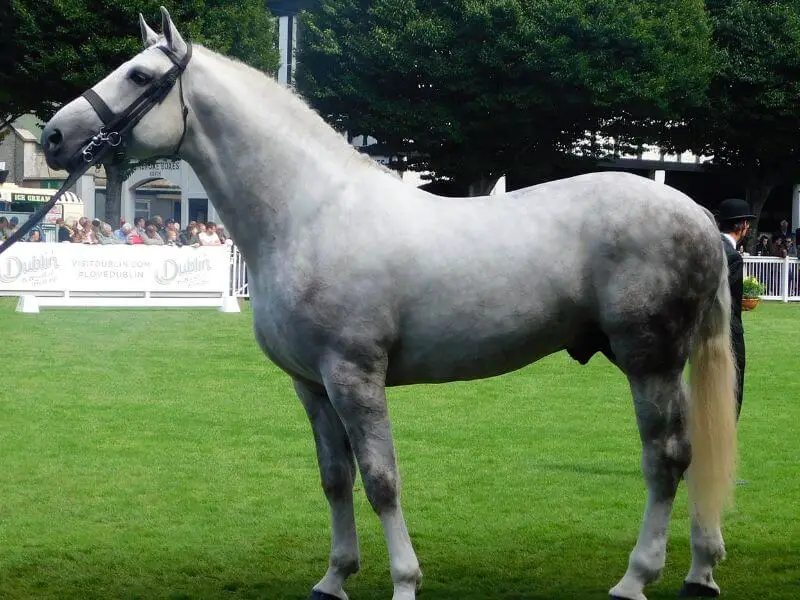
#13 The Irish Draft: A True Workhorse
The Irish Draft is a horse breed known for its strength and friendly nature.
It was born in the 18th century in Ireland and was made from a mix of Spanish and English horse breeds.
It has a height of about 15.2-16.3 hands and can weigh about 1,300-1,400 pounds.
What Makes the Irish Draft a Great Workhorse?
The Irish Draft was originally used a lot in farm work.
Why? Because it was good at working in harness and under saddle.
But even though people don’t use them as much for farm work anymore, they have found other ways to be helpful.
A New Kind of Workhorse
For example, the Irish Draft is now often used as a police horse. Police horses need to be calm and easy to work with. And the Irish Draft is perfect for this because it has a docile, or calm, temperament.
That means it doesn’t get scared or upset easily.
The Irish Draft is also used in showing and fox hunting. It has an active and flexible movement which makes it good at these jobs too.
The Irish Draft’s Look
This horse breed can come in any basic color. But one thing people don’t usually like is too many white markings. Other than that, it’s seen as a beautiful horse breed.
So, the Irish Draft isn’t just a horse. It’s a true workhorse that can do many different jobs. Whether it’s on a farm, with the police, or in a show, the Irish Draft is a great choice.
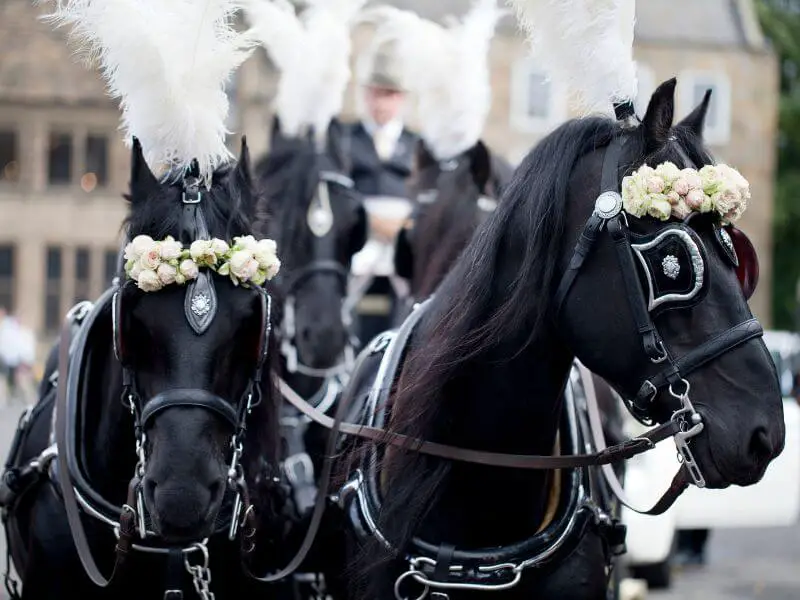
#14 Friesian Horses: The Ideal Work Horse
Born and raised in the Dutch islands of Friesland, the Friesian horse is well-known for its quiet, calm temperament.
Their glossy black coat often changes shade when shedding or when faded from the sun, sometimes taking on a darker bay color. Chestnut and bay Friesians also exist, though they’re not as common.
Physical Features
These horses have a sturdy build, standing 14.5-17 hands tall and weighing between 1,200-1,400 pounds. They’re not just about strength, though.
Friesian horses also have long, wavy manes and tails, and feathers on their lower legs. These feathers are extra hair that makes their legs look fancy.
The Friesian as a Work Horse
Friesian horses have a history of hard work. They’ve been used in farming and even in wars. This is because they’re strong and can do heavy work, but they’re also calm and easy to handle. Even kids can work with them safely.
But today, you don’t often see Friesian horses pulling plows on farms. Their strength and calm nature make them perfect for other jobs. You might see them in dressage competitions or in movies.
They’re great in these roles because they’re good listeners, eager to please, and they move gracefully.
However, despite being lighter than other draft horses, Friesians are still capable of doing hard work.
Concluding on Friesians
In the end, the Friesian horse is a hard-working, versatile breed. Its calm nature and strength make it a good choice for work, especially for tasks that need both power and patience.
Whether in a competition, a movie, or on a farm, the Friesian is a breed that’s both helpful and impressive.
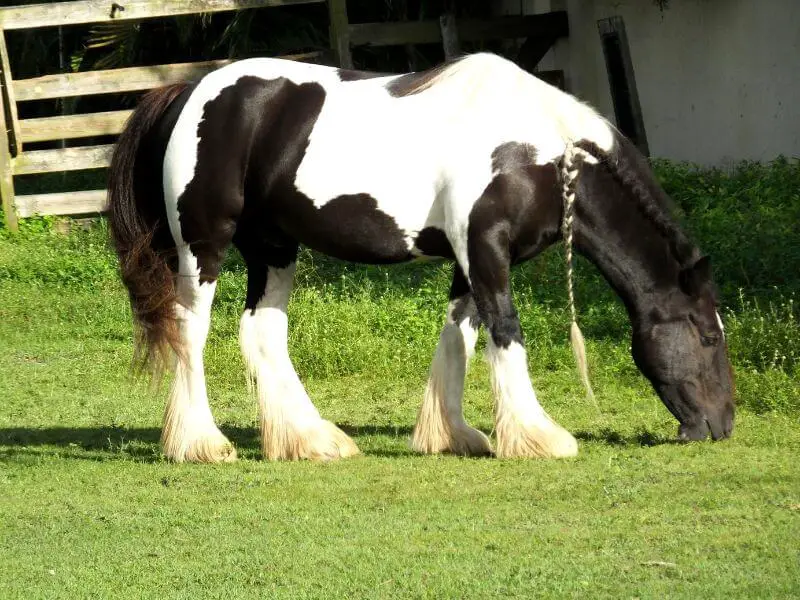
#15 Gypsy Vanner: The Workhorse With a Heart
If you’re a fan of strong, hardworking horses, then you must learn about the Gypsy Vanner. This breed isn’t just a pretty face; it’s one of the best workhorses you can find!
Gypsy Vanners, also called Gypsy Cobs, came from Great Britain. These horses were bred by a group of people called the Romanichal.
The Romanichal used them to pull their homes, which were mobile houses called “caravans”.
Not Just a Pretty Horse
Gypsy Vanners are often admired for their looks. They have a unique pie-bald, pinto pattern and their legs are feathered from the knees down. Yet, these horses are so much more than their appearance. Gypsy Vanners are strong and intelligent.
But what really sets them apart is their personality. They are very easy-going and kind animals, always ready to lend a hoof.
Gypsy Vanners in North America
North Americans first got to know the Gypsy Vanner in 1998. Since then, they’ve won the hearts of many. Today, they’re one of the most beloved workhorse breeds in North America.
Why Gypsy Vanners Make Great Workhorses
- Size and Strength: Gypsy Vanners stand between 14 and 15.2 hands tall and weigh 1100 to 1700 lb. They have big chests and heavy hips, supported by strong bones and large hooves. This makes them perfectly suited for heavy work.
- Stamina: Gypsy Vanners are known for their impressive endurance. They can work hard for a long time without getting tired.
- Temperament: Gypsy Vanners are calm and easy-going. They don’t get upset easily, which makes them reliable work partners.
In Conclusion
Gypsy Vanners are a perfect blend of strength, endurance, and a great temperament. They were bred to work, and work is what they do best. Whether on a farm, ranch, or pulling a caravan, these horses are always ready to give their all. With a Gypsy Vanner by your side, you’ve got a faithful and hardworking partner. These horses truly live up to the saying, “as strong as a horse.”
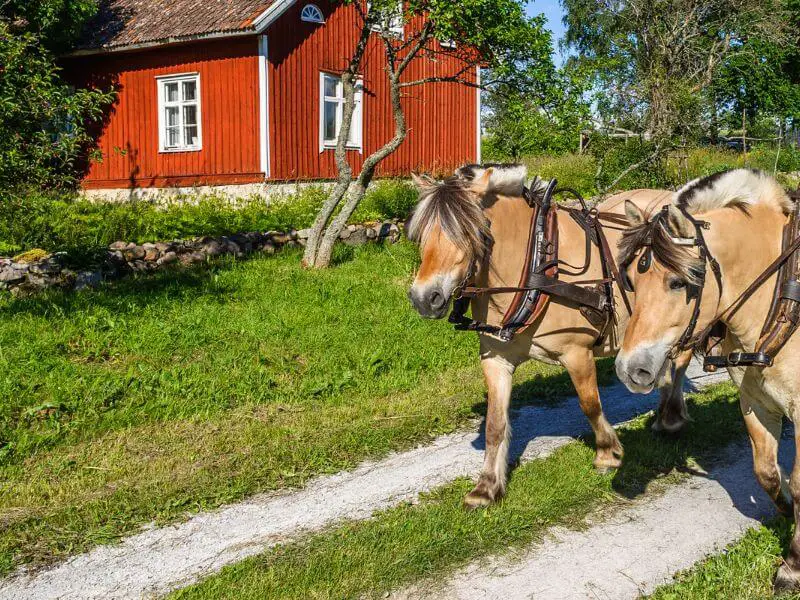
#16 Fjord Horse: The Work Horse of Norway
The Fjord Horse is one of the most hardworking horse breeds out there. This horse breed comes from Norway, a country known for its cold and mountainous landscape.
And it’s in this challenging environment that Fjord Horses show their true strength and skills as work horses.
Their Role in History
Fjord Horses were used in ancient times for heavy work. They were the ones pulling heavy loads, tilling the fields, and helping the people of Norway with many of their tasks.
This horse breed was even used by Vikings, the brave warriors from Norway’s past. This shows how long the Fjord Horse has been a work horse, trusted for their strength and endurance.
Physical Strength and Size
One of the first things you’ll notice about a Fjord Horse is how strong they look.
They are small compared to other horse breeds, standing only around 13-14.2 hands high, but they are very muscular. This makes them perfect for hard work.
Even though they are small, they can lift heavy loads and work for long periods.
Temperament: Calm and Willing
Another great thing about Fjord Horses is their calm and willing nature. They don’t easily get scared or nervous, and they are always ready to work.
This makes them very easy to handle, even for kids and people who are just starting to learn about horses. I know of a few farms that exclusively teach students with Fjord horses and they are very calm and willing.
Their Use Today
Today, Fjord Horses are still used for different types of work.
They are known for their excellent endurance and sure-footed gaits. These horses are often used for farm work, driving, and even horseback riding.
Despite the advancements in technology, Fjord Horses continue to be a reliable choice when it comes to work horses.
Colors
Most Fjord Horses are bay dun, but they can also have other colors. Some Fjord Horses can be all sorts of dun coat colors that look gray, red, pale gold, or yellow.
But no matter what color they are, all Fjord Horses have the strength and endurance to work hard and help their owners.
In conclusion, the Fjord Horse is a remarkable work horse. From their strength and endurance to their calm and willing nature, these horses are indeed a great choice for those in need of a reliable work horse.
Despite their small size, they can do the work of bigger horses and they do it with great efficiency and dedication. Whether on a farm or in a riding school, the Fjord Horse is sure to impress with its work ethic and ability.
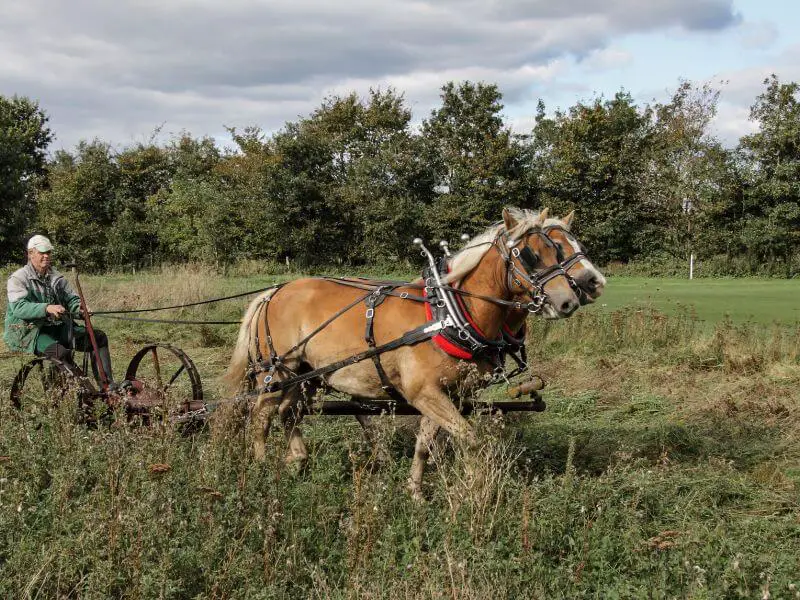
#17 Haflinger as a Workhorse
The Haflinger is a hard-working breed of horse that originated in Austria and Northern Italy. These horses stand at a moderate height between 13.5 and 15 hands, showcasing a perfect blend of strength and size.
Physical Traits
One thing you’ll notice about the Haflinger is its distinctive color. It always sports a chestnut coat with a flaxen mane and tail, giving it a unique and striking look.
This horse breed has a muscular body which helps in carrying out heavy tasks.
Types of Haflingers
There are two types of Haflingers, both equally hardworking:
- The Shorter, Stockier Type: This is the traditional workhorse. It’s built for heavy-duty tasks.
- The Taller, Lighter Type: This type is used for both riding and lighter work tasks.
Work Uses
Haflingers are versatile workhorses. Here’s where they really shine:
- Military Work: These horses are still used by the military because of their strength and adaptability.
- Forestry Work: Haflingers are great for forestry work due to their muscular build.
- Riding and Therapy: Haflingers are also used for riding and therapy work. Their kind nature and smooth gaits make them ideal for these roles.
Temperament
Haflingers are more than just workhorses; they’re sociable animals that love the company of humans. They’re intelligent, gentle, and can be trusted to get the job done.
But personally I have noticed Haflingers with there intelligence can sometimes have a bit of a stubborn streak or pony like behavior. Not always but I have noticed this with a handful from within the breed.
In conclusion, the Haflinger is a breed of horse that perfectly combines strength, versatility, and a kind nature, making it an ideal workhorse. Whether for heavy-duty tasks, forestry work, or therapy, this breed is more than up to the task.
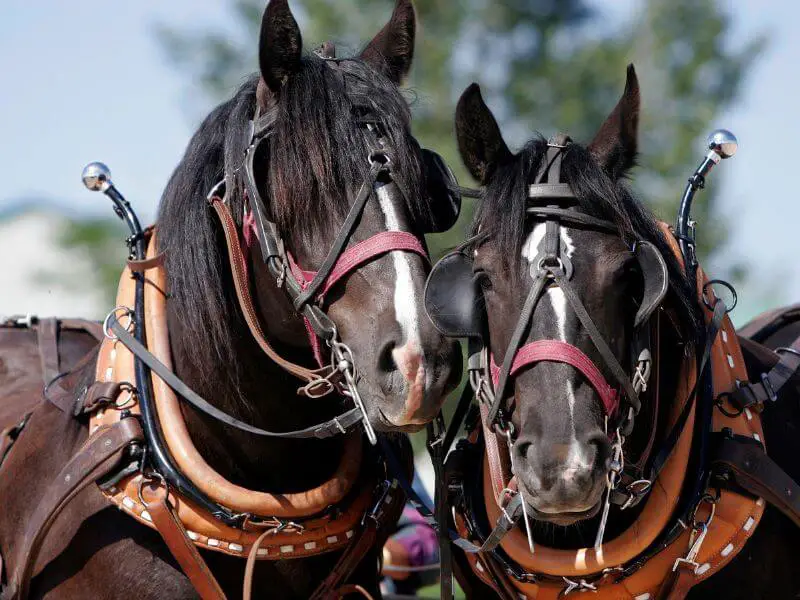
FAQ’s About Work Horses
What do we mean when we say “work horse”?
A “work horse” refers to a horse that is used to do heavy jobs. These jobs could be pulling a wagon, a plow for farming, or even heavy loads. So when you hear the term “work horse,” think about a horse that is doing some hard work!
What kind of horse is usually used for jobs and work?
There are specific breeds of horses that are often used for jobs and work. These are usually bigger and stronger horses, known as draft horses. Some of the well-known draft horse breeds are Clydesdales, Percherons, and Shires.
Why do we call these big strong horses “Draft Horses”?
“Draft” in “Draft Horses” comes from a word that means to pull or draw. So, Draft Horses are horses that are used to pull or draw heavy loads. They are specially bred to be strong and have a lot of stamina to work for longer periods.
What are “Draft Horses” exactly?
Draft horses are a type of horse that are bred to be big and strong. They are taller and heavier than most other types of horses. This makes them great for doing hard work, like pulling heavy wagons or plowing fields. They are also known for being gentle and patient, which makes them good for working around people.
Is there a certain breed of horse known for being strong and good at work?
Yes, there are several breeds of horses that are known for being strong and good at work. These include the Clydesdale, the Percheron, the Shire, the Belgian, and the Suffolk Punch. These breeds are all types of draft horses, which means they are bred to be strong and hard-working.
Which is the biggest type of Draft Horse?
The Shire is generally recognized as the biggest type of draft horse. Shire horses can stand as tall as 6 feet at the shoulder and can weigh up to 2,400 pounds! That’s heavier than a small car. They are known for their immense size, strength, and gentle nature.
Are Draft Horses okay for beginners to work with?
Yes, Draft Horses are generally okay for beginners to work with. They are known for their calm and patient nature. However, because of their size, they require proper handling and training. It’s important for beginners to have an experienced person guide them while working with these large animals. They’re gentle giants, but remember, they’re still giants!
Which horse breed is commonly employed as a work horse?
The Belgian Draft Horse is commonly employed as a work horse. This breed is known for its significant strength and docile temperament, making it ideal for heavy labor.
Which Breed Of Horse Is Known For Its Strength As A Work Horse?
The Shire breed is known for its strength as a work horse. This English breed is among the largest and strongest of draft horses, often employed in roles that require substantial power, such as pulling heavy loads.
What Breed Of Horses Do The Amish Typically Use For Their Work?
The Amish typically use the Standardbred and Belgian Draft horses for their work. Both of these breeds are hardy and adaptable, well-suited for various kinds of labor, including plowing fields and pulling buggies.
If you’re eager to learn more about horses, make sure to check out our other related blog posts.
Cheers, Kacey
P.S. Did you like this article? Gallop over to:

